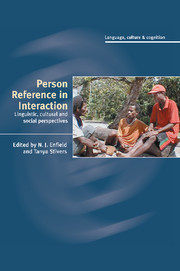1 - Person reference in interaction
Published online by Cambridge University Press: 22 September 2009
Summary
Introduction
Person reference is a subject that stands at a central intersection between the various behavioural sciences. How persons are classified and individuated lies at the heart of social theory; how different cultures do so has preoccupied anthropology; how we recognize them from face and voice is much investigated in psychology and the cognitive neurosciences; how we refer to persons has been a central topic in philosophy; and the grammatical machinery involved in tracking protagonists in discourse is an important topic in linguistics. Yet, despite the fact that person reference has this centrality, the empirical study of person reference in natural conversation – the central genre of language use – has been curiously neglected, particularly from a cross-cultural perspective that might throw much light on the relation between culture, social structure and language use.
This volume attempts to fill this gap. Each chapter looks at person reference in a specific language and culture, as reflected in everyday language use attempting to understand unmarked versus marked usage primarily with respect to initial third-person references but also in subsequent and in first-person references. We see quite quickly that how people refer to individuals in interaction is amazingly varied. There are different name formats: simple first name Laurie, first-name-plus-surname Serena Edwards, title-plus-surname Missus Hallman. There are kin titles like Mommy or Granny. There are more complex possessed kin terms in which kinship references triangulate through someone else: Suzanne's husband, Laurie's dad. There are descriptions like that guy who does those c'mmercials.
- Type
- Chapter
- Information
- Person Reference in InteractionLinguistic, Cultural and Social Perspectives, pp. 1 - 20Publisher: Cambridge University PressPrint publication year: 2007
- 35
- Cited by



